Business Strategy: Linking Performance and Alliances Report
VerifiedAdded on 2021/01/02
|7
|1613
|86
Report
AI Summary
This report analyzes three key articles related to business strategy. The first article discusses the 'people process model,' emphasizing the importance of linking individual performance to organizational goals through vertical, horizontal, and temporal linkages, with HR playing a crucial role. The second article focuses on the development of an integrated model for strategic alliances, highlighting the significance of environmental scanning, including broad, industry, and competitive environments, to prevent alliance failures. The third article examines corporate governance and corporate diversification strategies, emphasizing the relationship between corporate governance and diversification for value creation, and the importance of balancing shareholder interests with ethical business practices in a competitive environment. The report concludes by underscoring the interconnectedness of these elements for overall business success.

Business Strategy
Paraphrase This Document
Need a fresh take? Get an instant paraphrase of this document with our AI Paraphraser

Table of Contents
ARTICLE 1......................................................................................................................................3
Key Areas...............................................................................................................................3
Review....................................................................................................................................3
Findings..................................................................................................................................4
ARTICLE 2 .....................................................................................................................................4
Key Areas...............................................................................................................................4
Review....................................................................................................................................4
Findings..................................................................................................................................5
ARTICLE 3 .....................................................................................................................................5
Key Areas...............................................................................................................................5
Review....................................................................................................................................6
Findings..................................................................................................................................6
REFERENCES................................................................................................................................7
ARTICLE 1......................................................................................................................................3
Key Areas...............................................................................................................................3
Review....................................................................................................................................3
Findings..................................................................................................................................4
ARTICLE 2 .....................................................................................................................................4
Key Areas...............................................................................................................................4
Review....................................................................................................................................4
Findings..................................................................................................................................5
ARTICLE 3 .....................................................................................................................................5
Key Areas...............................................................................................................................5
Review....................................................................................................................................6
Findings..................................................................................................................................6
REFERENCES................................................................................................................................7
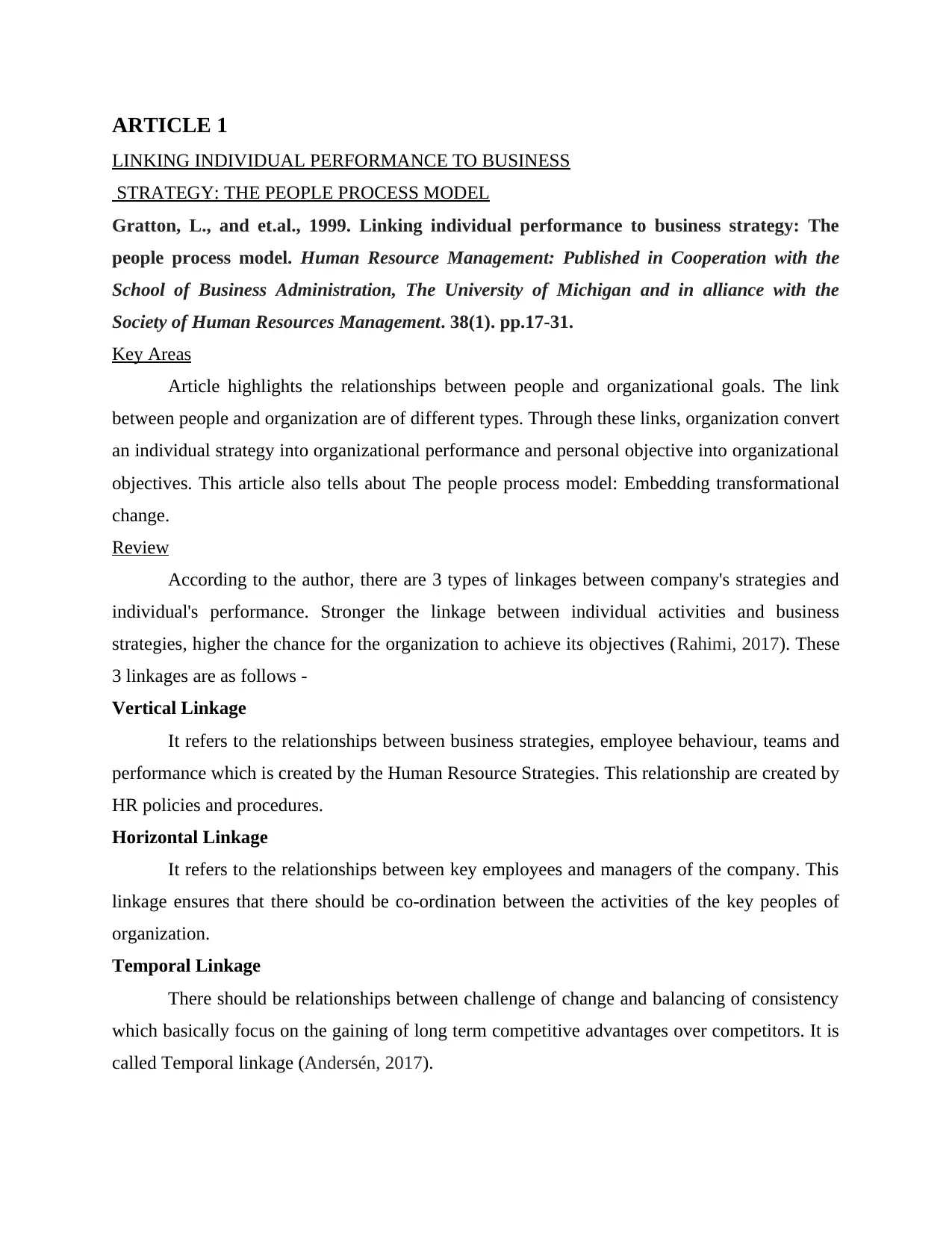
ARTICLE 1
LINKING INDIVIDUAL PERFORMANCE TO BUSINESS
STRATEGY: THE PEOPLE PROCESS MODEL
Gratton, L., and et.al., 1999. Linking individual performance to business strategy: The
people process model. Human Resource Management: Published in Cooperation with the
School of Business Administration, The University of Michigan and in alliance with the
Society of Human Resources Management. 38(1). pp.17-31.
Key Areas
Article highlights the relationships between people and organizational goals. The link
between people and organization are of different types. Through these links, organization convert
an individual strategy into organizational performance and personal objective into organizational
objectives. This article also tells about The people process model: Embedding transformational
change.
Review
According to the author, there are 3 types of linkages between company's strategies and
individual's performance. Stronger the linkage between individual activities and business
strategies, higher the chance for the organization to achieve its objectives (Rahimi, 2017). These
3 linkages are as follows -
Vertical Linkage
It refers to the relationships between business strategies, employee behaviour, teams and
performance which is created by the Human Resource Strategies. This relationship are created by
HR policies and procedures.
Horizontal Linkage
It refers to the relationships between key employees and managers of the company. This
linkage ensures that there should be co-ordination between the activities of the key peoples of
organization.
Temporal Linkage
There should be relationships between challenge of change and balancing of consistency
which basically focus on the gaining of long term competitive advantages over competitors. It is
called Temporal linkage (Andersén, 2017).
LINKING INDIVIDUAL PERFORMANCE TO BUSINESS
STRATEGY: THE PEOPLE PROCESS MODEL
Gratton, L., and et.al., 1999. Linking individual performance to business strategy: The
people process model. Human Resource Management: Published in Cooperation with the
School of Business Administration, The University of Michigan and in alliance with the
Society of Human Resources Management. 38(1). pp.17-31.
Key Areas
Article highlights the relationships between people and organizational goals. The link
between people and organization are of different types. Through these links, organization convert
an individual strategy into organizational performance and personal objective into organizational
objectives. This article also tells about The people process model: Embedding transformational
change.
Review
According to the author, there are 3 types of linkages between company's strategies and
individual's performance. Stronger the linkage between individual activities and business
strategies, higher the chance for the organization to achieve its objectives (Rahimi, 2017). These
3 linkages are as follows -
Vertical Linkage
It refers to the relationships between business strategies, employee behaviour, teams and
performance which is created by the Human Resource Strategies. This relationship are created by
HR policies and procedures.
Horizontal Linkage
It refers to the relationships between key employees and managers of the company. This
linkage ensures that there should be co-ordination between the activities of the key peoples of
organization.
Temporal Linkage
There should be relationships between challenge of change and balancing of consistency
which basically focus on the gaining of long term competitive advantages over competitors. It is
called Temporal linkage (Andersén, 2017).
⊘ This is a preview!⊘
Do you want full access?
Subscribe today to unlock all pages.

Trusted by 1+ million students worldwide
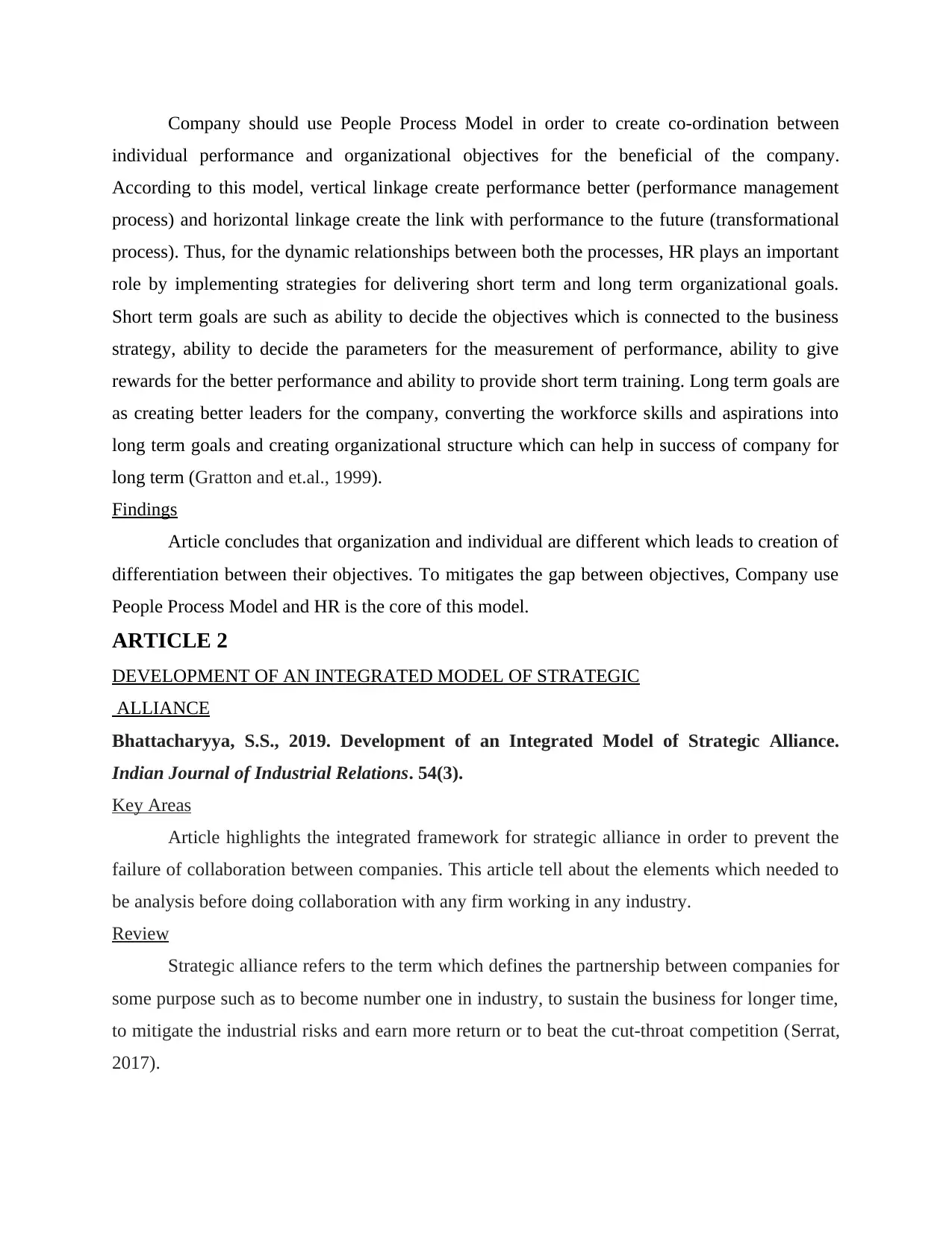
Company should use People Process Model in order to create co-ordination between
individual performance and organizational objectives for the beneficial of the company.
According to this model, vertical linkage create performance better (performance management
process) and horizontal linkage create the link with performance to the future (transformational
process). Thus, for the dynamic relationships between both the processes, HR plays an important
role by implementing strategies for delivering short term and long term organizational goals.
Short term goals are such as ability to decide the objectives which is connected to the business
strategy, ability to decide the parameters for the measurement of performance, ability to give
rewards for the better performance and ability to provide short term training. Long term goals are
as creating better leaders for the company, converting the workforce skills and aspirations into
long term goals and creating organizational structure which can help in success of company for
long term (Gratton and et.al., 1999).
Findings
Article concludes that organization and individual are different which leads to creation of
differentiation between their objectives. To mitigates the gap between objectives, Company use
People Process Model and HR is the core of this model.
ARTICLE 2
DEVELOPMENT OF AN INTEGRATED MODEL OF STRATEGIC
ALLIANCE
Bhattacharyya, S.S., 2019. Development of an Integrated Model of Strategic Alliance.
Indian Journal of Industrial Relations. 54(3).
Key Areas
Article highlights the integrated framework for strategic alliance in order to prevent the
failure of collaboration between companies. This article tell about the elements which needed to
be analysis before doing collaboration with any firm working in any industry.
Review
Strategic alliance refers to the term which defines the partnership between companies for
some purpose such as to become number one in industry, to sustain the business for longer time,
to mitigate the industrial risks and earn more return or to beat the cut-throat competition (Serrat,
2017).
individual performance and organizational objectives for the beneficial of the company.
According to this model, vertical linkage create performance better (performance management
process) and horizontal linkage create the link with performance to the future (transformational
process). Thus, for the dynamic relationships between both the processes, HR plays an important
role by implementing strategies for delivering short term and long term organizational goals.
Short term goals are such as ability to decide the objectives which is connected to the business
strategy, ability to decide the parameters for the measurement of performance, ability to give
rewards for the better performance and ability to provide short term training. Long term goals are
as creating better leaders for the company, converting the workforce skills and aspirations into
long term goals and creating organizational structure which can help in success of company for
long term (Gratton and et.al., 1999).
Findings
Article concludes that organization and individual are different which leads to creation of
differentiation between their objectives. To mitigates the gap between objectives, Company use
People Process Model and HR is the core of this model.
ARTICLE 2
DEVELOPMENT OF AN INTEGRATED MODEL OF STRATEGIC
ALLIANCE
Bhattacharyya, S.S., 2019. Development of an Integrated Model of Strategic Alliance.
Indian Journal of Industrial Relations. 54(3).
Key Areas
Article highlights the integrated framework for strategic alliance in order to prevent the
failure of collaboration between companies. This article tell about the elements which needed to
be analysis before doing collaboration with any firm working in any industry.
Review
Strategic alliance refers to the term which defines the partnership between companies for
some purpose such as to become number one in industry, to sustain the business for longer time,
to mitigate the industrial risks and earn more return or to beat the cut-throat competition (Serrat,
2017).
Paraphrase This Document
Need a fresh take? Get an instant paraphrase of this document with our AI Paraphraser
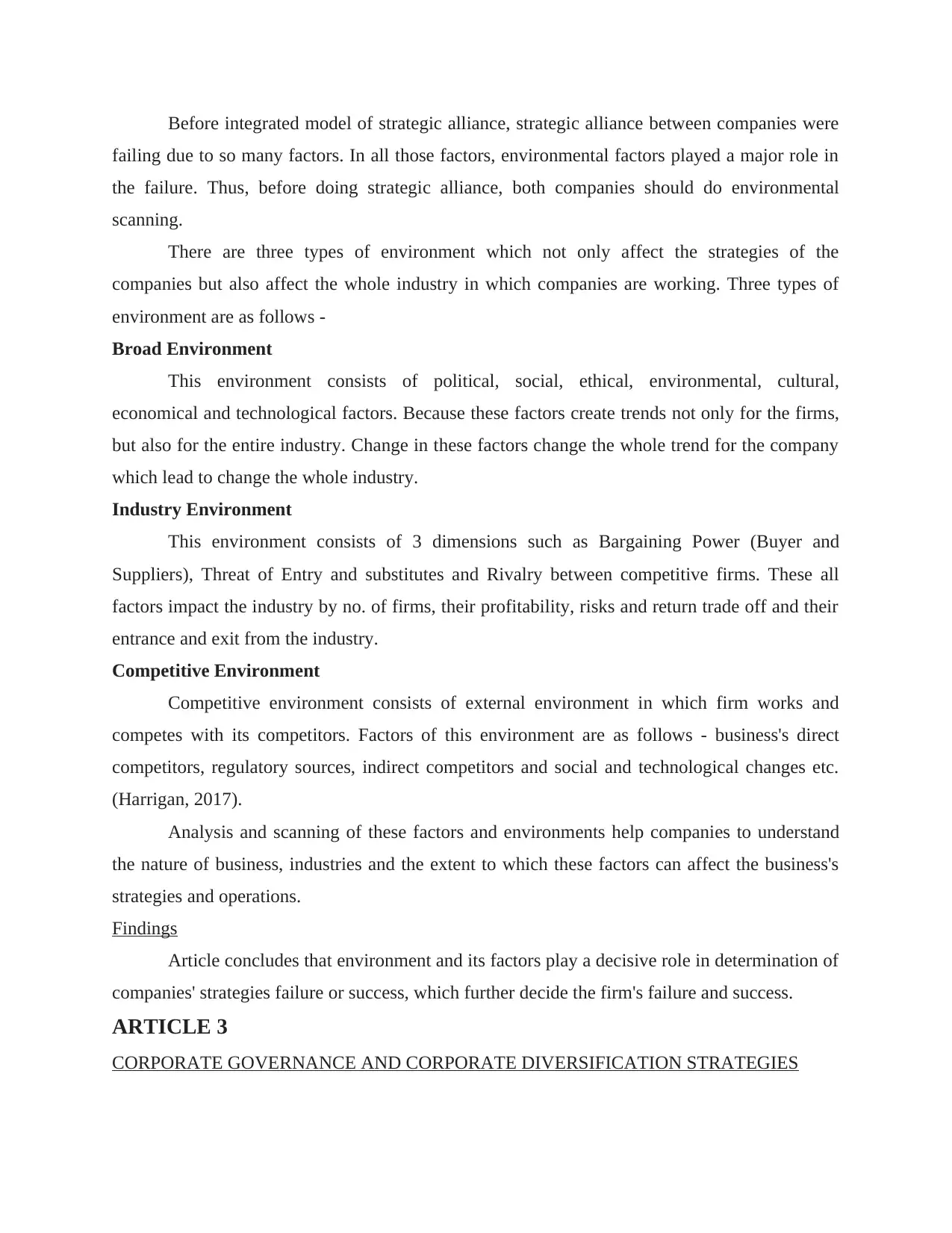
Before integrated model of strategic alliance, strategic alliance between companies were
failing due to so many factors. In all those factors, environmental factors played a major role in
the failure. Thus, before doing strategic alliance, both companies should do environmental
scanning.
There are three types of environment which not only affect the strategies of the
companies but also affect the whole industry in which companies are working. Three types of
environment are as follows -
Broad Environment
This environment consists of political, social, ethical, environmental, cultural,
economical and technological factors. Because these factors create trends not only for the firms,
but also for the entire industry. Change in these factors change the whole trend for the company
which lead to change the whole industry.
Industry Environment
This environment consists of 3 dimensions such as Bargaining Power (Buyer and
Suppliers), Threat of Entry and substitutes and Rivalry between competitive firms. These all
factors impact the industry by no. of firms, their profitability, risks and return trade off and their
entrance and exit from the industry.
Competitive Environment
Competitive environment consists of external environment in which firm works and
competes with its competitors. Factors of this environment are as follows - business's direct
competitors, regulatory sources, indirect competitors and social and technological changes etc.
(Harrigan, 2017).
Analysis and scanning of these factors and environments help companies to understand
the nature of business, industries and the extent to which these factors can affect the business's
strategies and operations.
Findings
Article concludes that environment and its factors play a decisive role in determination of
companies' strategies failure or success, which further decide the firm's failure and success.
ARTICLE 3
CORPORATE GOVERNANCE AND CORPORATE DIVERSIFICATION STRATEGIES
failing due to so many factors. In all those factors, environmental factors played a major role in
the failure. Thus, before doing strategic alliance, both companies should do environmental
scanning.
There are three types of environment which not only affect the strategies of the
companies but also affect the whole industry in which companies are working. Three types of
environment are as follows -
Broad Environment
This environment consists of political, social, ethical, environmental, cultural,
economical and technological factors. Because these factors create trends not only for the firms,
but also for the entire industry. Change in these factors change the whole trend for the company
which lead to change the whole industry.
Industry Environment
This environment consists of 3 dimensions such as Bargaining Power (Buyer and
Suppliers), Threat of Entry and substitutes and Rivalry between competitive firms. These all
factors impact the industry by no. of firms, their profitability, risks and return trade off and their
entrance and exit from the industry.
Competitive Environment
Competitive environment consists of external environment in which firm works and
competes with its competitors. Factors of this environment are as follows - business's direct
competitors, regulatory sources, indirect competitors and social and technological changes etc.
(Harrigan, 2017).
Analysis and scanning of these factors and environments help companies to understand
the nature of business, industries and the extent to which these factors can affect the business's
strategies and operations.
Findings
Article concludes that environment and its factors play a decisive role in determination of
companies' strategies failure or success, which further decide the firm's failure and success.
ARTICLE 3
CORPORATE GOVERNANCE AND CORPORATE DIVERSIFICATION STRATEGIES
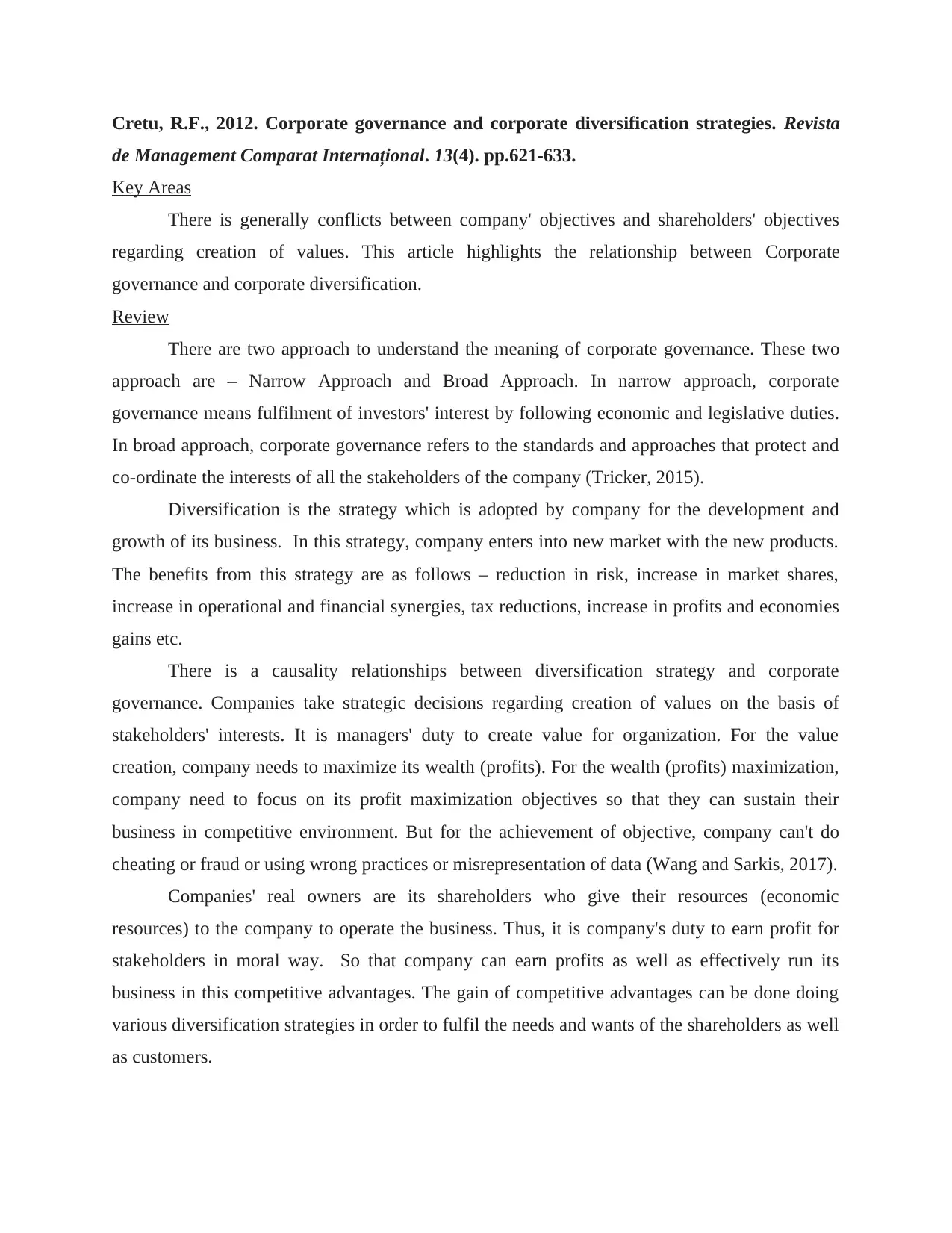
Cretu, R.F., 2012. Corporate governance and corporate diversification strategies. Revista
de Management Comparat Internațional. 13(4). pp.621-633.
Key Areas
There is generally conflicts between company' objectives and shareholders' objectives
regarding creation of values. This article highlights the relationship between Corporate
governance and corporate diversification.
Review
There are two approach to understand the meaning of corporate governance. These two
approach are – Narrow Approach and Broad Approach. In narrow approach, corporate
governance means fulfilment of investors' interest by following economic and legislative duties.
In broad approach, corporate governance refers to the standards and approaches that protect and
co-ordinate the interests of all the stakeholders of the company (Tricker, 2015).
Diversification is the strategy which is adopted by company for the development and
growth of its business. In this strategy, company enters into new market with the new products.
The benefits from this strategy are as follows – reduction in risk, increase in market shares,
increase in operational and financial synergies, tax reductions, increase in profits and economies
gains etc.
There is a causality relationships between diversification strategy and corporate
governance. Companies take strategic decisions regarding creation of values on the basis of
stakeholders' interests. It is managers' duty to create value for organization. For the value
creation, company needs to maximize its wealth (profits). For the wealth (profits) maximization,
company need to focus on its profit maximization objectives so that they can sustain their
business in competitive environment. But for the achievement of objective, company can't do
cheating or fraud or using wrong practices or misrepresentation of data (Wang and Sarkis, 2017).
Companies' real owners are its shareholders who give their resources (economic
resources) to the company to operate the business. Thus, it is company's duty to earn profit for
stakeholders in moral way. So that company can earn profits as well as effectively run its
business in this competitive advantages. The gain of competitive advantages can be done doing
various diversification strategies in order to fulfil the needs and wants of the shareholders as well
as customers.
de Management Comparat Internațional. 13(4). pp.621-633.
Key Areas
There is generally conflicts between company' objectives and shareholders' objectives
regarding creation of values. This article highlights the relationship between Corporate
governance and corporate diversification.
Review
There are two approach to understand the meaning of corporate governance. These two
approach are – Narrow Approach and Broad Approach. In narrow approach, corporate
governance means fulfilment of investors' interest by following economic and legislative duties.
In broad approach, corporate governance refers to the standards and approaches that protect and
co-ordinate the interests of all the stakeholders of the company (Tricker, 2015).
Diversification is the strategy which is adopted by company for the development and
growth of its business. In this strategy, company enters into new market with the new products.
The benefits from this strategy are as follows – reduction in risk, increase in market shares,
increase in operational and financial synergies, tax reductions, increase in profits and economies
gains etc.
There is a causality relationships between diversification strategy and corporate
governance. Companies take strategic decisions regarding creation of values on the basis of
stakeholders' interests. It is managers' duty to create value for organization. For the value
creation, company needs to maximize its wealth (profits). For the wealth (profits) maximization,
company need to focus on its profit maximization objectives so that they can sustain their
business in competitive environment. But for the achievement of objective, company can't do
cheating or fraud or using wrong practices or misrepresentation of data (Wang and Sarkis, 2017).
Companies' real owners are its shareholders who give their resources (economic
resources) to the company to operate the business. Thus, it is company's duty to earn profit for
stakeholders in moral way. So that company can earn profits as well as effectively run its
business in this competitive advantages. The gain of competitive advantages can be done doing
various diversification strategies in order to fulfil the needs and wants of the shareholders as well
as customers.
⊘ This is a preview!⊘
Do you want full access?
Subscribe today to unlock all pages.

Trusted by 1+ million students worldwide
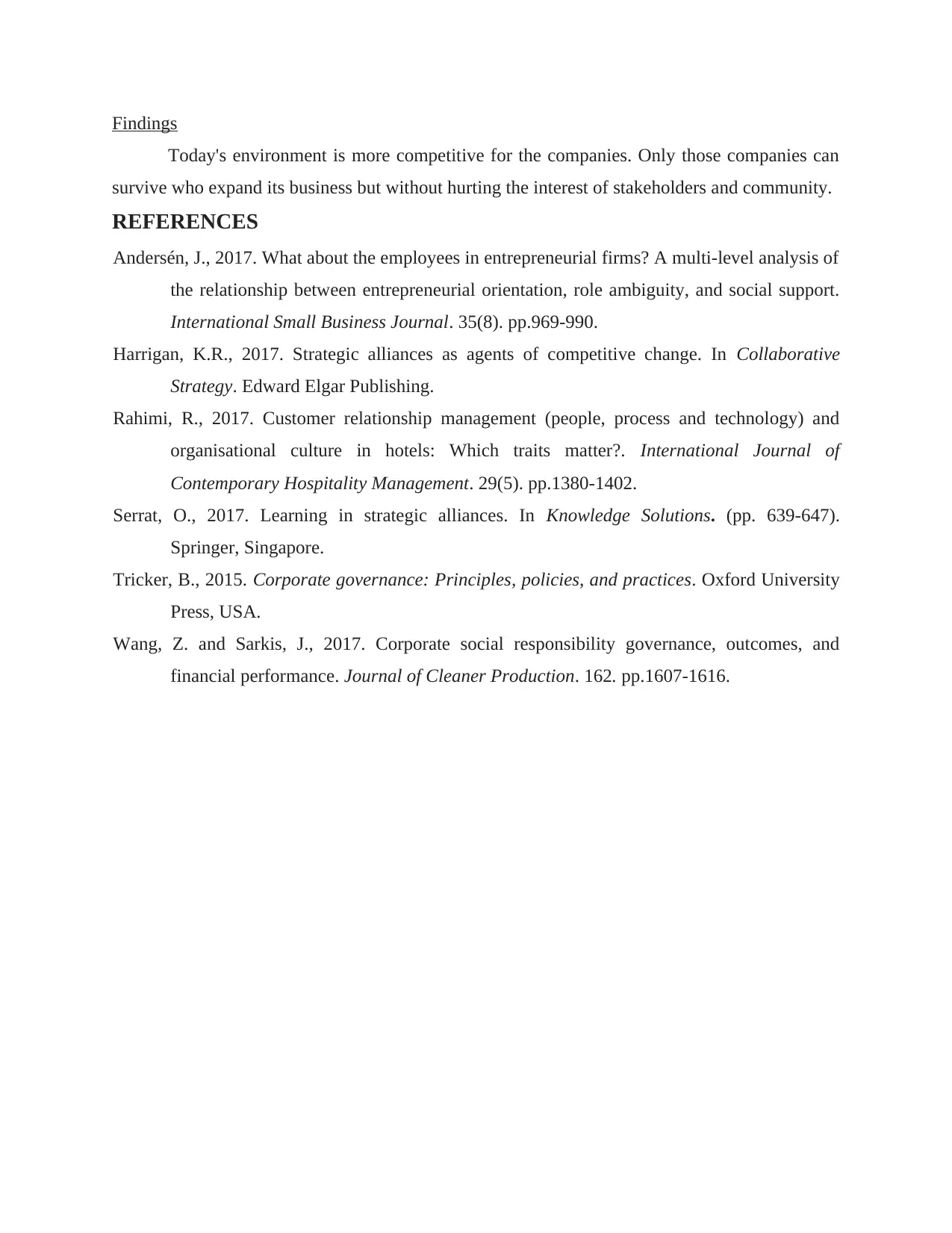
Findings
Today's environment is more competitive for the companies. Only those companies can
survive who expand its business but without hurting the interest of stakeholders and community.
REFERENCES
Andersén, J., 2017. What about the employees in entrepreneurial firms? A multi-level analysis of
the relationship between entrepreneurial orientation, role ambiguity, and social support.
International Small Business Journal. 35(8). pp.969-990.
Harrigan, K.R., 2017. Strategic alliances as agents of competitive change. In Collaborative
Strategy. Edward Elgar Publishing.
Rahimi, R., 2017. Customer relationship management (people, process and technology) and
organisational culture in hotels: Which traits matter?. International Journal of
Contemporary Hospitality Management. 29(5). pp.1380-1402.
Serrat, O., 2017. Learning in strategic alliances. In Knowledge Solutions. (pp. 639-647).
Springer, Singapore.
Tricker, B., 2015. Corporate governance: Principles, policies, and practices. Oxford University
Press, USA.
Wang, Z. and Sarkis, J., 2017. Corporate social responsibility governance, outcomes, and
financial performance. Journal of Cleaner Production. 162. pp.1607-1616.
Today's environment is more competitive for the companies. Only those companies can
survive who expand its business but without hurting the interest of stakeholders and community.
REFERENCES
Andersén, J., 2017. What about the employees in entrepreneurial firms? A multi-level analysis of
the relationship between entrepreneurial orientation, role ambiguity, and social support.
International Small Business Journal. 35(8). pp.969-990.
Harrigan, K.R., 2017. Strategic alliances as agents of competitive change. In Collaborative
Strategy. Edward Elgar Publishing.
Rahimi, R., 2017. Customer relationship management (people, process and technology) and
organisational culture in hotels: Which traits matter?. International Journal of
Contemporary Hospitality Management. 29(5). pp.1380-1402.
Serrat, O., 2017. Learning in strategic alliances. In Knowledge Solutions. (pp. 639-647).
Springer, Singapore.
Tricker, B., 2015. Corporate governance: Principles, policies, and practices. Oxford University
Press, USA.
Wang, Z. and Sarkis, J., 2017. Corporate social responsibility governance, outcomes, and
financial performance. Journal of Cleaner Production. 162. pp.1607-1616.
1 out of 7
Related Documents
Your All-in-One AI-Powered Toolkit for Academic Success.
+13062052269
info@desklib.com
Available 24*7 on WhatsApp / Email
![[object Object]](/_next/static/media/star-bottom.7253800d.svg)
Unlock your academic potential
Copyright © 2020–2025 A2Z Services. All Rights Reserved. Developed and managed by ZUCOL.





